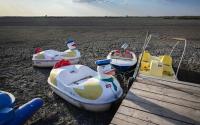Fossil leaves buried 55 million years ago show, for the first time, that rapid warming not only changed animal communities, but plant communities as well; and that the ancient warm spell may be representative of global warming's effects in Earth's future, according to an international team of researchers.
"There has been an absence of fossil leaf sites dating to the Paleocene-Eocene Thermal Maximum (PETM)," says Dr. Francesca A. Smith, postdoctoral researcher in geosciences, Penn State.
Scientists have long known that during the PETM, mammalian communities changed, but without plant fossil samples, they could not say the same for plants. The PETM is unusual because the warming of 9 to 18 degrees Fahrenheit occurred in only 10,000 years, a geologically short time span. Researchers believe that increased carbon dioxide caused the warming, but underlying causes of the increase are still being debated. "The PETM provides an important analog to present-day anthropogenic global warming, because the two episodes are inferred to have similar rates and magnitudes of carbon release and climate change," the researchers report in today's (Nov. 11) issue of Science.
Dr. Scott Wing, Department of Paleobiology, Smithsonian Museum of Natural History, led the expedition to the southeastern Bighorn Basin, Wyoming, that found new boundary sequences of fossils that covered the change from the Paleocene to the Eocene. These sequences, unlike those found in the past, contained both leaf and pollen fossils.
"Finding fossil leaves from this period is difficult," says Smith. "Leaves are only rarely preserved and the fossil beds for this time period are only 130 to 160 feet thick."
To ensure that the new areas were actually in the proper time period, the researchers used two dating methods. Smith and Dr. Katherine H. Freeman, professor of geosciences, Penn State, looked at the chemical signature of the carbon in the fossils. From marine sediment studies, researchers know that during this time period, the heavier form of carbon, carbon 13, occurred less frequently in the atmosphere. Smith and Freeman identified these fossil beds as having the proper carbon composition for the PETM. Coupling carbon with the mammalian fossils found in the beds, including the oldest known horses that were the size of a cat and the ancestors of modern primates, the researchers identified the beds as coming from the PETM.
Analysis of the plant fossils showed that the plants from before and after the PETM were from typical forests for the time, containing relatives of dawn redwood, alder, sycamore, walnut and sassafras. However, the bean family, including relatives of poinsettia, sumac and paw-paw, dominate the fossils during the PETM. These are plants more commonly found during that time period, 1,000 miles to the south in Mississippi, Louisiana and Texas. These plants migrated north in 10,000 years or less.
The leaf fossils also allowed researchers to look at the PETM climate. By comparing the numbers of smooth edged leaves to toothed leaves, they found that the temperature change in the Bighorn basin was about 9 degrees Fahrenheit warmer during the PETM. By looking at the leaves' surface areas, researchers could estimate precipitation.
"Using these methods, we can infer the temperature changes and determine that the area was dry at the beginning of this period and wet toward the end," says Smith. "Rainfall declined about 40 percent and later recovered."
At the end of the PETM, forests returned to their original composition with the addition of plants like relatives of the wingnut and linden that migrated into the area from Europe across Arctic land bridges. "So much of the information that we have about ancient terrestrial climate during the PETM comes from the Bighorn basin area because it is one of a handful of terrestrial sequences for that time period," says Smith "To interpret the record, we need to have as much information as we can get."
According to Wing, similarly rapid changes in flora might be expected in the future as a result of human-induced global warming.
Other members of the research team include Guy J. Harrington, University of Birmingham, UK; Jonathan I. Bloch, Florida Museum of Natural History, Gainesville, and Douglas M. Boyer, Stony Brook University. The National Science Foundation, Roland Brown Fund and Florida Museum of Natural History supported this research.






